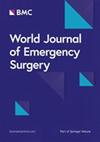Comparing outcomes in patients with exsanguinating injuries: an Eastern Association for the Surgery of Trauma (EAST), multicenter, international trial evaluating prioritization of circulation over intubation (CAB over ABC)
IF 6
1区 医学
Q1 EMERGENCY MEDICINE
引用次数: 0
Abstract
Hemorrhage is a major cause of preventable trauma deaths, and the ABC approach is widely used during the primary survey. We hypothesize that prioritizing circulation over intubation (CAB) can improve outcomes in patients with exsanguinating injuries. A prospective observational study involving international trauma centers was conducted. Patients with systolic blood pressure below 90 who were intubated within 30 min of arrival were included. Prioritizing circulation (CAB) was defined as delaying intubation until blood products were started, and/or bleeding control was performed before securing the airway. Demographics, clinical data, and outcomes were recorded. The study included 278 eligible patients, with 61.5% falling within the “CAB” cohort and 38.5% in the “ABC” cohort. Demographic and disease characteristics, including age, sex, ISS, use of blood products, and other relevant factors, exhibited comparable distributions between the two cohorts. The CAB group had a higher proportion of penetrating injuries and more patients receiving intubation in the operating room. Notably, patients in the CAB group demonstrated higher GCS scores, lower SBP values before intubation but higher after intubation, and a significantly lower incidence of cardiac arrest and post-intubation hypotension. Key outcomes revealed significantly lower 24-hour mortality in the CAB group (11.1% vs. 69.2%), a lower rate of renal failure, and a higher rate of ARDS. Multivariable logistic regression models showed a 91% reduction in the odds of mortality within 24 h and an 89% reduction at 30 days for the CAB cohort compared to the ABC cohort. These findings suggest that prioritizing circulation before intubation is associated with improved outcomes in patients with exsanguinating injuries. Post-intubation hypotension is observed to be correlated with worse outcomes. The consideration of prioritizing circulation over intubation in patients with exsanguinating injuries, allowing for resuscitation, or bleeding control, appears to be associated with potential improvements in survival. Emphasizing the importance of circulation and resuscitation is crucial, and this approach might offer benefits for various bleeding-related conditions.比较外伤患者的预后:东部创伤外科协会 (EAST)、多中心国际试验,评估循环优先于插管(CAB 优先于 ABC)的情况
大出血是可预防的创伤死亡的主要原因,ABC 法在初级调查中被广泛使用。我们假设,优先循环而非插管(CAB)可以改善外伤患者的预后。我们开展了一项由国际创伤中心参与的前瞻性观察研究。研究对象包括收缩压低于 90 且在到达后 30 分钟内插管的患者。循环优先(CAB)的定义是,在确保气道安全之前,延迟插管直到开始使用血液制品和/或进行出血控制。研究记录了人口统计学、临床数据和结果。研究共纳入了 278 名符合条件的患者,其中 61.5% 属于 "CAB "队列,38.5% 属于 "ABC "队列。两组患者的人口统计学特征和疾病特征,包括年龄、性别、ISS、血液制品使用情况和其他相关因素,分布情况相当。CAB组的穿透性损伤比例更高,在手术室接受插管治疗的患者也更多。值得注意的是,CAB 组患者的 GCS 评分较高,插管前 SBP 值较低,但插管后 SBP 值较高,心脏骤停和插管后低血压的发生率明显较低。主要结果显示,CAB 组 24 小时死亡率明显较低(11.1% 对 69.2%),肾功能衰竭发生率较低,ARDS 发生率较高。多变量逻辑回归模型显示,与 ABC 组相比,CAB 组 24 小时内的死亡率降低了 91%,30 天内的死亡率降低了 89%。这些研究结果表明,在插管前优先考虑循环与改善外伤患者的预后有关。据观察,插管后低血压与较差的预后有关。对有外伤的患者来说,优先考虑血液循环而不是插管,以便进行复苏或控制出血,似乎与生存率的潜在提高有关。强调循环和复苏的重要性至关重要,这种方法可能对各种与出血有关的情况有益。
本文章由计算机程序翻译,如有差异,请以英文原文为准。
求助全文
约1分钟内获得全文
求助全文
来源期刊

World Journal of Emergency Surgery
EMERGENCY MEDICINE-SURGERY
CiteScore
14.50
自引率
5.00%
发文量
60
审稿时长
10 weeks
期刊介绍:
The World Journal of Emergency Surgery is an open access, peer-reviewed journal covering all facets of clinical and basic research in traumatic and non-traumatic emergency surgery and related fields. Topics include emergency surgery, acute care surgery, trauma surgery, intensive care, trauma management, and resuscitation, among others.
 求助内容:
求助内容: 应助结果提醒方式:
应助结果提醒方式:


